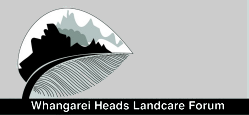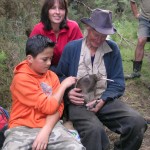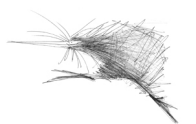The Whangarei Heads is a special place with great beaches, great ‘mountains’, great bush, with lots of rare, special and pretty unique wildlife. The people who live there are pretty special too – and very committed when it comes to looking after their backyard.
Because the special nature of the place is continuously under threat – by weeds, possums, rats, stoats and development, it is really important that people commit to ‘action on the ground’ to keep their backyard so special.
The community has embraced the concept of ‘landcare’ – of people getting together as a group to look after their backyards. There are 9 community driven projects spread through the Whangarei Heads working to control the weeds and pests, and encouraging their neighbours to do the same. These projects are represented by the Whangarei Heads Landcare Forum (WHLF), a registered incorporated society with charitable status.
The WHLF helps the community groups to access wider funding while maintaining the focus of their projects where it matters most – in their ‘back yards’.
Keeping everyone in touch with what is going on is also really important – sharing of information, ideas and enthusiasm is facilitated by the regular meetings of the WHLF. Want to know more?
Contact:
Chairperson: Juliet Langley langleyjuliet@yahoo.com
Treasurer: Martin Hunt, o.flowers@actrix.co.nz
Secretary: Helen Moodie, helen.moodie@landcare.org.nz
WHLF Kiwi Recovery project
Best of all for Whangarei Heads – there are kiwi in people’s backyards!
Thanks to eight years of intensive control of stoats, ferrets and wild cats from Bream Head to the margins of Taiharuru Estuary and Parua Bay, there are now more than 200 kiwi in the Whangarei Heads area. Todd Hamilton is contracted to provide the trapping expertise for the project.
Kiwi numbers have also been supplemented by the addition of kiwi from a DOC sanctuary west of Whangarei. The birds are first transferred as young chicks to Limestone Island until they reach 1200g in size and then are moved to the Heads area. Todd also tracks a number of these kiwi with radio transmitters, which gives information on survival and breeding and also reinforces the presence of kiwi for landowners.
Reminding landowners about the importance of dog control is another crucial component. Unfortunately – dogs love to ‘investigate’ kiwi – and that investigation usually kills the bird. So it is essential that people are aware of the importance of tying their dog up at night, keeping it under control at all times and even asking contractors to leave their dogs at home. Stray dogs should be reported to the dog control officers of Environmental Northland on 09 438 7513. Tell them it is a kiwi area and they should respond.
More people are reporting sightings of kiwi, more kiwi chick footprints being seen and the annual listening survey is providing encouraging signs over most of the Heads of a growing kiwi population.
For email updates on the kiwi recovery project or more information, contact: Todd Hamilton –021 1145 385 hamiltont@maxnet.co.nz




